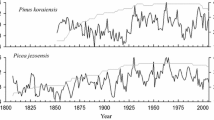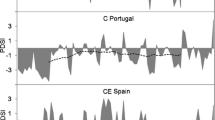Abstract
Key message
Temperature is a major limiting factor of Pinus koraiensis radial growth, while which exhibited various growth responses at different sites of its distribution area to recent climate warming.
Abstract
Six Korean pine (Pinus koraiensis) tree-ring chronologies were developed in northeast Asia. Growth trends in recent decades were compared and main factors limiting growth were identified within each site. The spatio-temporal stability of climate–growth relationships were also tested for important climate variables. Results showed that temperature played a key role in controlling Korean pine growth, while recent growth showed strong geographic patterns. Tree growth in recent decades at two south and high altitude sites increased with temperature, remained constant for two low-altitude sites at its central distribution, and decreased for two moderately altitude sites at its distribution north margin. Tree-ring principle of the ecological amplitude was proved again, i.e., trees growing near the margin of its natural range has higher climate sensitivity. Drought stress due to temperature increases appeared to be a primary reason for Korean pine growth decline, whereas varying degrees of drought stress were distinctly dependent on site conditions. Variation of climate-growth relationships over time for different sites was consistent with their recent growth. Two average chronologies for six sites revealed a decreased (Heihe, Mudanjiang, and Liangshui) or inverse (Dunhua, WPS, and Wuying) growth response to rapid warming since 1980, which was possibly related to unique site conditions and various large-scale climate impacts. In addition, our results indicated that modeling possible reactions of forest to global warming or reconstructing past climate need to consider diverse spatio-temporal variations of climate-growth relationships of Korean pine in northeast Asia.







Similar content being viewed by others
References
Andersson F (2005) Ecosystems of the world 6: coniferous forests. Elsevier, Amsterdam
Barber VA, Juday GP, Finney BP (2000) Reduced growth of Alaskan white spruce in the twentieth century from temperature-induced drought stress. Nature 405:668–673
Biondi F, Waikul K (2004) DENDROCLIM2002: a C++ program for statistical calibration of climate signals in tree-ring chronologies. Comput Geosci 30:303–311
Bonan GB (2008) Forests and climate change: forcings, feedbacks, and the climate benefits of forests. Science 320:1444–1449
Briffa KR, Schweingruber FH, Jones PD, Osborn TJ, Shiyatov SG, Vaganov EA (1998) Reduced sensitivity of recent tree-growth to temperature at high northern latitudes. Nature 391:678–682
Carrer M, Urbinati C (2006) Long-term change in the sensitivity of tree-ring growth to climate forcing in Larix decidua. New Phytol 170:861–872
Chen L, Wu S, Dai E (2011) Analysis of the tree-ring width chronologies of Pinus koraiensis and Larix olgensis on Changbai Mountains, Northeast China. Geogr Res 30:1147–1155
Coppola A, Leonelli G, Salvatore MC, Pelfini M, Baroni C (2012) Weakening climatic signal since mid-20th century in European larch tree-ring chronologies at different altitudes from the Adamello-Presanella Massif (Italian Alps). Quat Res 77:344–354
Dai A, Trenberth KE, Qian T (2004) A global dataset of Palmer Drought Severity Index for 1870–2002: relationship with soil moisture and effects of surface warming. J Hydrometeorol 5:1117–1130
D’Arrigo RD, Kaufmann RK, Davi N, Jacoby GC, Laskowski C, Myneni RB, Cherubini P (2004) Thresholds for warming-induced growth decline at elevational tree line in the Yukon Territory, Canada. Global Biogeochem Cy 18:GB3021
D’Arrigo R, Wilson R, Liepert B, Cherubini P (2008) On the ‘divergence problem’in northern forests: a review of the tree-ring evidence and possible causes. Global Planet Change 60:289–305
Fritts HC (1976) Tree rings and climate. Academic Press, San Diego
Gea-Izquierdo G, Cherubini P, Cañellas I (2011) Tree-rings reflect the impact of climate change on Quercus ilex L. along a temperature gradient in Spain over the last 100years. Forest Ecol Manag 262:1807–1816
Gómez-Guerrero A, Silva LC, Barrera-Reyes M et al (2013) Growth decline and divergent tree ring isotopic composition (δ13C and δ18O) contradict predictions of CO2 stimulation in high altitudinal forests. Global Change Biol 19:1748–1758
Griesbauer HP, Green DS (2012) Geographic and temporal patterns in white spruce climate-growth relationships in Yukon, Canada. Forest Ecol Manag 267:215–227
Holmes RL (1983) Computer-assisted quality control in tree-ring dating and measurement. Tree-Ring Bull 43:69–78
IPCC (2007) Climate change 2007-the physical science basis: Working group I contribution to the fourth assessment report of the IPCC, vol 4. Cambridge University Press, Cambridge
James TM (2011) Temperature sensitivity and recruitment dynamics of Siberian larch (Larix sibirica) and Siberian spruce (Picea obovata) in northern Mongolia’s boreal forest. Forest Ecol Manag 262:629–636
Johnson AH, Cook ER, Siccama TG (1988) Climate and red spruce growth and decline in the northern Appalachians. Proc Natl Acad Sci USA 85:5369–5373
Jump AS, Hunt JM, Penuelas J (2006) Rapid climate change-related growth decline at the southern range edge of Fagus sylvatica. Global Change Biol 12:2163–2174
Jump AS, Hunt JM, Penuelas J (2007) Climate relationships of growth and establishment across the altitudinal range of Fagus sylvatica in the Montseny Mountains, northeast Spain. Ecoscience 14:507–518
Kolbek J, Šrůtek M, Box EO (2003) Forest vegetation of Northeast Asia. Kluwer Academic Publishers, Dordrecht
Koprowski M, Przybylak R, Zielski A, Pospieszyńska A (2012) Tree rings of Scots pine (Pinus sylvestris L.) as a source of information about past climate in northern Poland. Int J Biometeorol 56:1–10
Leonelli G, Pelfini M, Battipaglia G, Cherubini P (2009) Site-aspect influence on climate sensitivity over time of a high-altitude Pinus cembra tree-ring network. Clim Change 96:185–201
Li J (1997) Ecology and management of mixed broadleaved-Korean pine forests. Northeast Forestry University Press, Harbin
Li G, Bai F, Sang W (2011) Different responses of radial growth to climate warming in Pinus koraiensis and Picea jezoensis var. komarovii at their upper elevational limits in Changbai Mountain, China. Chin J Plant Ecol 35:500–511
Liang E, Wang Y, Xu Y, Liu B, Shao X (2010) Growth variation in Abies georgei var. smithii along altitudinal gradients in the Sygera Mountains, southeastern Tibetan Plateau. Trees 24:363–373
Lloyd AH, Fastie CL (2002) Spatial and temporal variability in the growth and climate response of treeline trees in Alaska. Clim Change 52:481–509
Mérian P, Bontemps JD, Bergès L, Lebourgeois F (2011) Spatial variation and temporal instability in climate-growth relationships of sessile oak (Quercus petraea [Matt.] Liebl.) under temperate conditions. Plant Ecol 212:1855–1871
Millar CI, Stephenson NL, Stephens SL (2007) Climate change and forests of the future: managing in the face of uncertainty. Ecol Appl 17:2145–2151
Park WK, Seo JW, Kim Y, Oh JH (2001) July-August temperature of central Korea since AD 1700: reconstruction from tree rings of Korean pine (Pinus koraiensis). Palaeobotanist 50:107–111
Schweingruber FH (1996) Tree rings and environment: dendroecology. Paul Haupt AG Bern, Berne
Silva LC, Anand M, Leithead MD (2010) Recent widespread tree growth decline despite increasing atmospheric CO2. PLoS One 5:e11543
Tardif J, Camarero JJ, Ribas M, Gutiérrez E (2003) Spatiotemporal variability in tree growth in the Central Pyrenees: climatic and site influences. Ecol Monogr 73:241–257
Tuovinen M, McCarroll D, Grudd H, Jalkanen R, Los S (2009) Spatial and temporal stability of the climatic signal in northern Fennoscandian pine tree-ring width and maximum density. Boreas 38:1–12
Wang X, Brown PM, Zhang Y, Song L (2011) Imprint of the Atlantic multidecadal oscillation on tree-ring widths in Northeastern Asia since 1568. PLoS One 6:e22740
Wang H, Shao X, Jiang Y, Fang X, Wu S (2013) The impacts of climate change on the radial growth of Pinus koraiensis along elevations of Changbai Mountain in northeastern China. Forest Ecol Manag 289:333–340
Wang X, Li Z, Ma K (2014) Decreased sensitivity of tree growth to temperature in Southeast China after the 1976/’77 regime shift in Pacific climate. Sains Malays 43:9–19
Wei L, Wang H, Wang Q et al (1995) The influence of climate changes on Korean pine forest in China. Geogra Res 14:17–26
Wilmking M, Singh J (2008) Eliminating the” divergence problem” at Alaska’s northern treeline. Clim Past Discuss 4:741–759
Wilmking M, Juday GP, Barber VA, Zald HS (2004) Recent climate warming forces contrasting growth responses of white spruce at treeline in Alaska through temperature thresholds. Global Change Biol 10:1724–1736
Wilson R, D’Arrigo R, Buckley B et al (2007) A matter of divergence: tracking recent warming at hemispheric scales using tree ring data. J Geophys Res 112:D17103
Wu X, Liu H, Guo D, Anenkhonov OA, Badmaeva NK, Sandanov DV (2012) Growth decline linked to warming-induced water limitation in hemi-boreal forests. PLoS One 7:e42619
Xu D, Yan H (2001) A study of the impacts of climate change on the geographic distribution of Pinus koraiensis in China. Environ Int 27:201–205
Yin H, Guo P, Liu H, Huang L, Yu H, Guo S, Wang F (2009) Reconstruction of the October mean temperature since 1796 at Wuying from tree ring data. Adv Clim Change Res 5:18–23
Yin H, Wang J, Liu H, Huang L, Zhu H (2011) A research on the response of the radial growth of Pinus koraiensis to future climate change in the XiaoXing’AnLing. Acta Ecol Sinica 31:7343–7350
Youngblut DK, Luckman BH (2013) Evaluating the temperature sensitivity of radial growth patterns from whitebark pine in the western Canadian Cordillera. Dendrochronologia 31:16–28
Yu D, Liu J, Zhou L et al (2013) Spatial variation and temporal instability in the climate-growth relationship of Korean pine in the Changbai Mountain region of Northeast China. Forest Ecol Manag 300:96–105
Zhang Y, Wilmking M (2010) Divergent growth responses and increasing temperature limitation of Qinghai spruce growth along an elevation gradient at the northeast Tibet Plateau. Forest Ecol Manag 260:1076–1082
Zhao M, Running S (2010) Drought-induced reduction in global terrestrial net primary production from 2000 through 2009. Science 329:940–943
Zhou D, He H, Li X, Zhou C (2007) Potential impact of seasonal temperature increase pattern on the succession of coniferous-broadleaved Korean pine mixed forest in Xiaoxing’an Mountain. Chin J Appl Ecol 18:1925–1931
Zhu H, Fang X, Shao X, Yin Z (2009) Tree ring-based February-April temperature reconstruction for Changbai Mountain in Northeast China and its implication for East Asian winter monsoon. Clim Past 5:661–666
Acknowledgments
This research was supported by the Fundamental Research Funds for the Central Universities (2572014DA05), the Program for New Century Excellent Talents in University (NCET-12-0810), the National Natural Science Foundation of China (Nos. 41471168 and 31370463), and the Scientific Research Foundation for Returned Overseas Chinese Scholars Heilongjiang Province, China (LC2012C09). We are very grateful to two anonymous reviewers for their valuable comments and constructive suggestions, which greatly improved the paper.
Author information
Authors and Affiliations
Corresponding author
Ethics declarations
Conflict of interest
The authors declare no conflict of interest.
Additional information
Communicated by A. Braeuning and L. Eryuan.
Rights and permissions
About this article
Cite this article
Wang, X., Zhang, M., Ji, Y. et al. Temperature signals in tree-ring width and divergent growth of Korean pine response to recent climate warming in northeast Asia. Trees 31, 415–427 (2017). https://doi.org/10.1007/s00468-015-1341-x
Received:
Revised:
Accepted:
Published:
Issue Date:
DOI: https://doi.org/10.1007/s00468-015-1341-x




